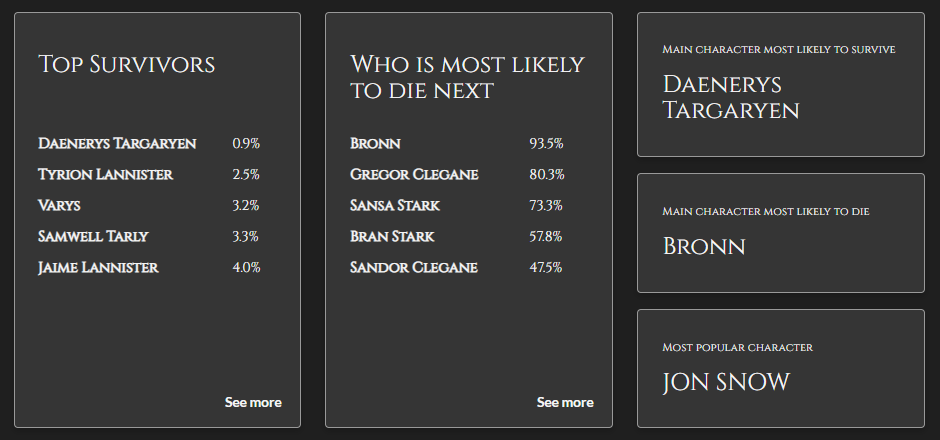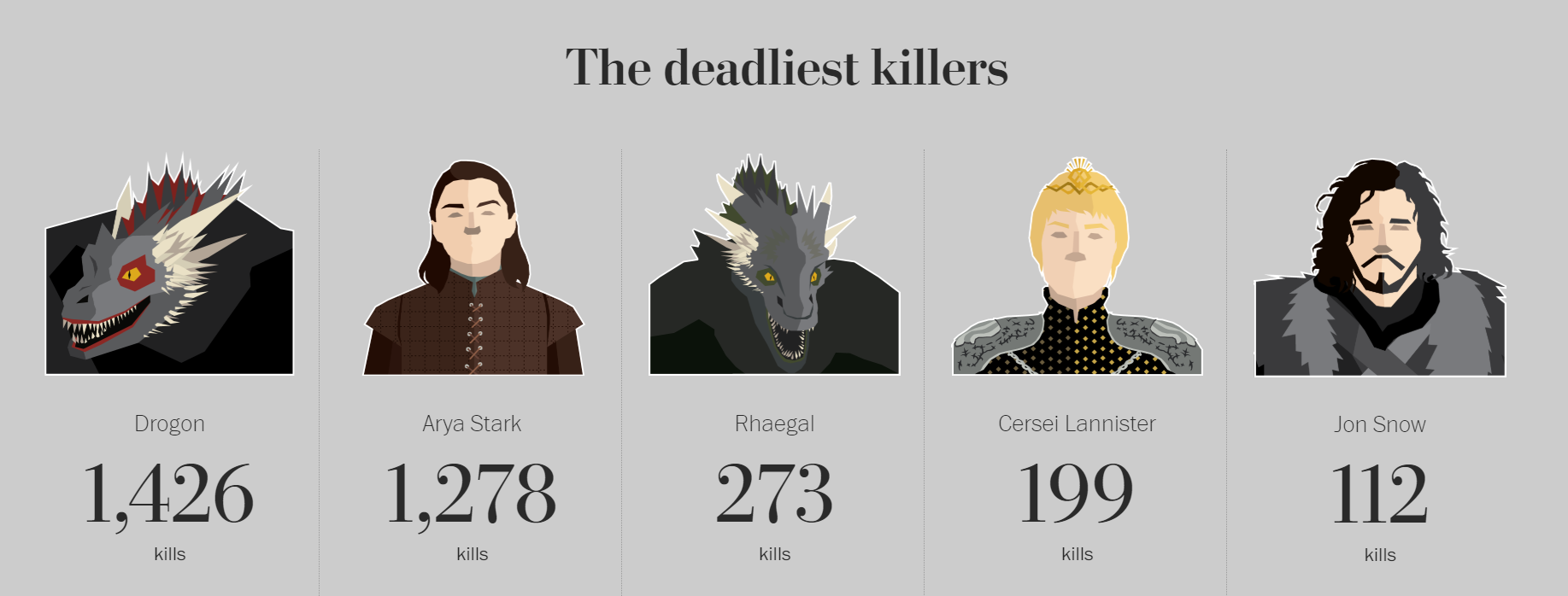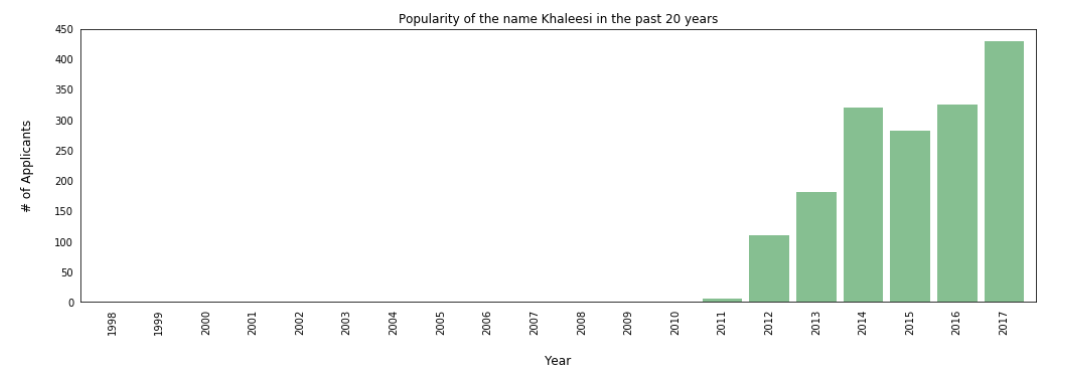Its reign is over, but “Game of Thrones” is far from a dead subject.
Fans spent the final seasons compiling painstaking analysis – complete with algorithms, AI and big data sets – to find hidden Easter eggs. And when there wasn’t anything to reveal beyond tallies, the numbers alone captured the mind-boggling detail which author George R. R. Martin weaved into his novels.
Here are some of our favorite data analyses on this unforgettable series.
Death, by the numbers
The jaw-dropping deaths of the show’s central characters were among its guiltiest of pleasures. But, was there a way to prepare yourself for seeing your favorite character’s head on the chopping block? As it turns out, data-savvy fans across the web tried to anticipate it beforehand.
Before season 8 had even gotten started, Technical University of Munich students developed an algorithm to predict who would survive the coming episodes, relying on scraped data from the Game of Thrones Wiki and Wiki of Ice and Fire, and factors such as gender, age, and house affiliation for a project they’ve titled “A Song of Ice and Data.” With a machine learning program that learned from its past errors, the project predicted that Daenerys Targaryen, Tyrion Lannister, Varys, Samwell Tarly and Jaime Lannister had the best chances of staying alive, while the alcoholic, womanizer Bronn, on the other hand, was predicted to die by a full 93.5 percent. Interestingly, their Potential Likelihood of Death (PLOD) algorithm was based on another, admittedly more serious survival-rate system applied in the medical field.

(source: Technical University of Munich)
A data science expert at DataRobot used a newly-developed machine learning approach known as light gradient boosted machines (LightGBMs) to further hone in on the reasons why our protagonists kept getting killed off. According to his analyses, 67 percent of those affiliated with the House of Targaryen were killed off, while only 5 percent of the Tyrells had met the same fate. (Clearly, things change in seasons 6 and 8).
He concluded that the number of dead relatives, or, in other words, the amount of turmoil within any one particular house, was a major predictive indicator for death.

For each machine learning algorithm in DataRobot, the platform builds a blueprint that optimizes the data for that specific algorithm. (source: DataRobot)

Using a technique called feature impact, DataRobot analyzes the extent to which each characters’ house of allegiance, age, whether they had dead relatives or not, and their gender may have contributed to their death. (source: DataRobot)
Over at The Washington Post, their elaborate illustrated webpage allows fans to relive every one of the shows 6,887 deaths, starting with the shocking beheading of the central protagonist, Ned Stark. Each death – which had to be updated frequently as each new episode dropped – are categorized by house allegiance, place and time of death, and method and circumstances of death. What are the deadliest places in the seven realms? That would be Winterfell (3,709 deaths), beyond the wall (1,092 deaths) and King’s Landing (1,357 deaths).
What about the deadliest characters?

(Source: The Washington Post)
The Post’s report also gives us a good chronicle of really how much bloodshed has been shown since the show first aired in 2011. In the first season started an impressive 59 deaths quickly set the tone. Season 3 featured a similarly “modest” death count, at 87, but one of the most memorable scenes: The Red Wedding, in which four major characters were killed, and the multi-layered Arya Stark was established as a ruthless warrior.
Season 6 was especially bloody, with 540 deaths, a full 168 of which happened in the Battle of the Bastards, and a near annihilation of full houses: Baratheon, Bolton and Tyrell.
Season 8, which ringed in at a whopping 4,548 deaths, proved – not surprisingly – to be the most fatal of them all.
What’s in a name?
It seems that GOT fever has also seeped into nearly every facet of our non-TV watching lives. Since its 2011 premier, it’s amassed one of the widest and most avid fan bases, including many who chose to name their newborn babies after their favorite, fiercest characters. According to an analysis of USA Name Data, a public data set created by the Social Security Administration, and published on the website Kaggle, the name “Daenerys” made its first appearance ever in 2013 – just after Daenerys emerged as a protagonist in Season 3. The use of the name continued to rise to 60 children in 2016 and 2017. The name “Brienne” joined as a first-timer to the name database, as the name for 5 children in 2016 and 2017.
Unsurprisingly, “Khaleesi” has gained in popularity, becoming the name for some 400 American children in the past few years. As Arya Stark, too, garnered her fearsome, bad-ass reputation, the numbers of baby “Arya”s spiked sharply.

In 2017, more than 400 American children were named Khaleesi, after GOT character Daenerys Targaryan’s title in the series (“Khaleesi” is used to refer to the wife of the khal in Dothraki culture). (source: Kaggle)
Winter is over, but will there be a spring?
With the final season’s premiere having garnered a whopping 17.4 million viewers, it’s hard to imagine HBO passing up on the opportunity to capitalize further on the series’ success. Our prediction: a prequel or a spinoff series.



